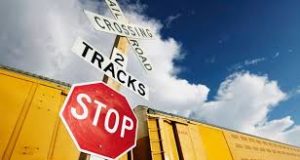BNSF Rail Talk: From Tracks to Trenches: BNSF Team Recognized for Heroic Response to Devastating Floods
Written by Eunice Archila, Staff Writer, BNSF
FORT WORTH ––In late January 2023, BNSF experienced historical flooding on our Bakersfield Subdivision in central California, with no indication of when the rains would stop.
Of concern was the Wasco station, where a creek flows underneath BNSF tracks that run east to west of the Sierra Mountain range. Little by little, banks were broken between the Wasco station and the Elmo station, signaling to our engineering team at Bakersfield that this was going to be a bigger issue than in years past.
“We didn’t realize how big it was going to get,” Division Engineer Sam Rubio recalled. “Once we started looking at historical facts about the Central Valley, we realized the bigger threat was going to be near the Angiola station.”
They began sifting through historical documents to better understand why this was happening and what they could expect. After meeting with a hydrologist, they were told tracks could be under 8 feet of water.

Flooded area in West Angiola, California/BNSF
In addition, the nearby Tulare Lake, which had been dry for decades — with farms and homes built within the lakebed – was expected to begin to fill again. The BNSF team knew they weren’t just going to have to ensure that trains were rerouted and tracks repaired, but the communities impacted during the flooding would also need their help.
“When we realized this happens every 60- 65 years, it explained why none of us had seen it before,” Rubio said. “It was surprising that locals had built in this area known to flood. It still caught many valley residents off guard.”
The circumstances were unprecedented, so every day, the team had to figure out the safest and best route to take.
“It was very much in the moment,” Rubio explained. “Suddenly roadways were flooding. Access to our tracks was changing daily. Each day we’d have to figure out what route wasn’t shut off due to flooding.”

Washout forming on tracks/BNSF
BNSF engineering employees did a great job checking the daily conditions and overcoming challenges, he noted. They would adjust to what lie ahead – and underwater.
“Maybe routes changed, maybe now you have to hyrail (a vehicle that can travel on both roads and railroad tracks) into a location,” Rubio said. “The power was down in various spots, so our signal team had to immediately install generators to keep our signals running to keep our switches operable. It was day-to-day challenge figuring out where the water was going.”
Thankfully, the Bakersfield Subdivision team didn’t have to deal with this by themselves. Tulare County set up an emergency headquarters, where BNSF sent a daily representative to understand where the next flood would occur. As they dealt with levee breaches and embankment failures, the county response team became a great partner for BNSF, sharing important information.

Flooded area near tracks/BNSF
BNSF also set up a command center in San Bernardino, California, which was staffed 24/7. Sharing information was crucial to continue operations and help team members in affected areas.
“If headquarters informed us that we were experiencing a levee failure in a specific location, we knew that meant the area would flood in the next two or three days,” Rubio said. “It was our signal to start work there and prepare for the flooding. At the very least, we were able to let people know to avoid affected areas.”
The flooding was a moving target, but the BNSF team ensured safety throughout.

Flooded tracks at night/BNSF
“The experience was surreal,” said Robert Reeves, signal inspector. “I’d always heard about a rare 1,000-year rain event that could bring back Lake Tulare. Two of our local lakes had modifications more than 20 years ago in anticipation of such events. The damage to the surrounding area was significant, and the potential for the situation to get worse was apparent.”
Reeves noted there were several locations where the tracks were washed out. “My motivation was to stay engaged and keep trains moving on safe infrastructure,” he said. “I’m lucky to be a part of a great railroad team. The amount of coordination that was needed between everyone (contractors, local irrigation, trucking companies, federal and state agencies), was impressive, especially at such a stressful time.”

Collapsing tracks with water running underneath the tracks/BNSF
Collaboration and teamwork were required to safely work through the floods from late January until May. The response included lifting tracks, strengthening infrastructure, and repairing embankments and levee failures by adding riprap rock and ballast stone.
Helicopters carried BNSF-donated ballast to help nearby counties fill levies. BNSF employees filled sacks, hooking them to the helicopters and then riding on them to help patch levies.

Left to right: Michael Serda, Samuel Rubio, John Garcez, Ramon Marrufo, Gary Sage, David Sandoval , Kale Phillips, Robert Reeves and Steven Phillips at the Employees of the Year 2023 award ceremony/BNSF
Rubio said the experience highlights the value of partnering with local agencies and knowing the history of flooding in one’s territory.
“Our employees were simply doing their best,” Rubio said. “BNSF’s safety culture is ingrained in us. No matter what the situation is, always take the safe course.”
Teamwork is also invaluable, he said. “I saw signal managers and supervisors in chest-high waters, working on signal bungalows to keep them in service, supervisors leading efforts to dump ballast, transportation managers helping us out with crews for ballast trains. I felt blessed to be with such great people during a time like that because everyone came together to help each other.”
For their quick, safe and thorough response, members of the Bakersfield Subdivision team were recognized at BNSF’s Employees of the Year ceremony. To them and others who assisted, thank you for safely handling unprecedented floods and keeping trains moving and communities safe.





